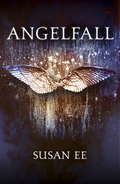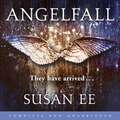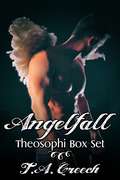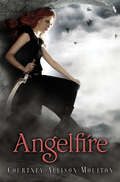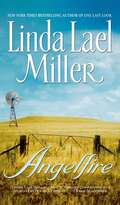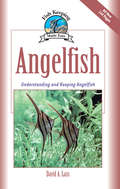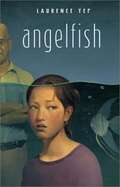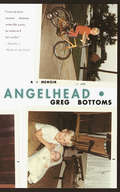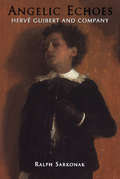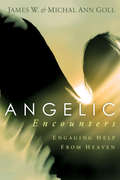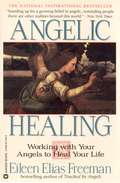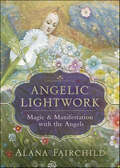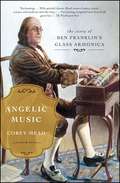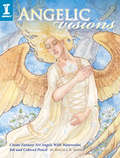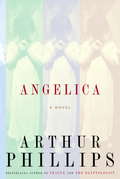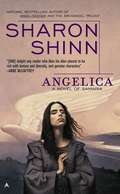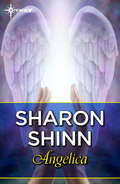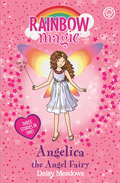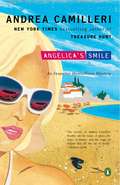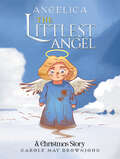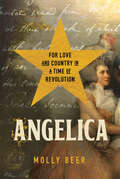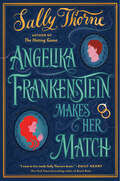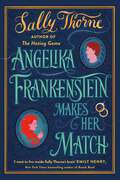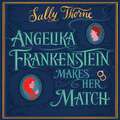- Table View
- List View
Angelfall: Penryn and the End of Days Book One (Penryn and the End of Days #Bk.1)
by Susan EeListed as one of Time Magazine's 100 Best Fantasy Books of All Time'An explosive, pulse-pounding journey' - Star'The new Young Adult fantasy phenomenon' - GraziaIt's been six weeks since the angels of the apocalypse destroyed the world as we know it. Only pockets of humanity remain.Savage street gangs rule the day while fear and superstition rule the night.When angels fly away with a helpless girl, her seventeen-year-old sister Penryn will do anything to get her back.Including making a deal with the enemy.
Angelfall: Penryn and the End of Days Book One (Penryn and the End of Days)
by Susan EeListed as one of Time Magazine's 100 Best Fantasy Books of All TimeIt's been six weeks since the angels of the apocalypse destroyed the world as we know it. Only pockets of humanity remain. Savage street gangs rule the day while fear and superstition rule the night. When angels fly away with a helpless girl, her seventeen-year-old sister Penryn will do anything to get her back...(P)2012 Brilliance Audio
Angelfall: Theosophi Box Set
by T. A. CreechAngels were nothing but stories to the Thomas brothers, fantastic beings that couldn’t exist. Until one landed in the pumpkin patch, that is. After that, it was wings and wide-eyed wonder, demons and discovery. Life went for a hell of a turn at the Thomas farm, no question, and it wasn’t all sunshine and roses. But after all is said and done, each of the brothers had the same, irrefutable thought: Worth it.Contains the stories:Sentinel: A fireball burning up the sky leads farmer Jason Thomas to the strangest thing he's ever found in his pumpkin patch. A man with wings. The evil that knocked Castiel out of the sky did him a favor. He’d heard the tales of Earth and now he has the chance to experience it himself. But he has a duty and needs to find a way back. Of course it isn’t going to be that easy.strong>Herald: Danny’s life has never been easy or straightforward. Farm life with his brothers was supposed to be a quiet existence, something he needed after his medical discharge from the Army. Then an angel fell from the sky. Gabriel isn’t at all pleased about the fall, and resistance is his only option against mortality's cruel bite. But can he guard his heart against Danny?General: Adam Thomas has always known the angels invading his home were going to liven up his life in all sorts of ways. But none of them are quite like the archangel who’s been comatose in Adam’s bed for months. It almost feels as if Adam is losing his mind, pining for Michael. Then Michael wakes up, and all hell breaks loose.Assassin: All that matters to Zophiel, an assassin for the Host, is that this is his last job. Levi is all he ever wanted in existence and he’s past ready to hang his halo where his heart is.
Angelfire (Angelfire Trilogy #1)
by Courtney Allison MoultonFirst there are nightmares. Every night Ellie is haunted by terrifying dreams of monstrous creatures that are hunting her, killing her. Then come the memories. When Ellie meets Will, she feels on the verge of remembering something just beyond her grasp. His attention is intense and romantic, and Ellie feels like her soul has known him for centuries. On her seventeenth birthday, on a dark street at midnight, Will awakens Ellie's power, and she knows that she can fight the creatures that stalk her in the grim darkness. Only Will holds the key to Ellie's memories, whole lifetimes of them, and when she looks at him, she can no longer pretend anything was just a dream. Now she must hunt. Ellie has power that no one can match, and her role is to hunt and kill the reapers that prey on human souls. But in order to survive the dangerous and ancient battle of the angels and the Fallen, she must also hunt for the secrets of her past lives and truths that may be too frightening to remember.
Angelfire (Australia #2)
by Linda Lael MillerThe New Zealand wilderness is no place for an innocent young girl escaping an arranged marriage....Shocked by the threat of being forced to marry an aging magistrate, Bliss Stafford flees her New Zealand home. But a chance encounter—and the barrel of her father's pistol—wed her to Jamie McKenna, a handsome, headstrong rancher whose bold touch inflamed her innocent senses. Yet Jamie's heart was captive to another—and to a hidden, bitter sorrow. But young, courageous Bliss is determined to face the secrets of his past and claim the radiant prize of a lifetime of tomorrows. Passion, heartache, and the power of romance set New Zealand aflame with Angelfire in Linda Lael Miller's lush tale of a young woman audacious enough to settle for nothing less than love.
Angelfish
by David A. LassDavid A Lass's introduction to angelfish fulfills its subtitle, "Understanding and Keeping Angelfish," and more. This colorful guide in the Fish Keeping Made Easy series discusses angelfish in their natural Amazon rain forest habitat in South America and the needs of this beautiful and recognizable fish in the home aquarium based on their dietary, water conditions, and behavior in the wild. The chapter "Angelfish Groups" describes the three species of angelfish (Pterophyllum altum, P. leopoldi, and P. scalare), the most popular twelve color variations seen in local pet stores, and the special traits of the species. Separate chapters are devoted to selection and care, feeding and diet, and reproduction. The author discusses the keeping of angelfish in an "all-angel" tank (shoal of angelfish!) as well as in a community tank, and gives solid advice on selection of equipment and live plants. A chapter on parasites and diseases will be of great use to all fishkeepers trying to avoid fungal, bacterial, and viral diseases in their tanks as well as general treatment protocols and hospital tanks. Glossary as well as resources of websites and publications conclude the guide.
Angelfish
by Laurence YepRobin, a young ballet dancer who is half Chinese and half white, works in a fish store for Mr. Tsow, a brusque Chinese who accuses her of being a half person and who harbors a bitter secret.
Angelhead: My Brother's Descent into Madness
by Greg BottomsA taut, powerful memoir of madness, Angelhead documents the violent, drug-addled descent of the author's brother, Michael, into schizophrenia. Beginning with Michael's first psychotic break--seeing God in his suburban bedroom window while high on LSD--Greg Bottoms recounts, in gripping, dramatic prose, the bizarre disappearances, suicide attempts, and the shocking crime that land Michael in the psychiatric wing of a maximum security prison. A work of nonfiction with the form and imagery of a novel, Angelhead enables the reader to witness not only the fragmenting of a mind, but of a family as well. "A tour-de-force memoir. . . . Bottoms writes like a poet, he writes like he is on fire." --Esquire, Book of the Year, 2000. "Angelhead is a brilliant, albeit inconceivably sad book. The fact that Bottoms survived the ordeal is incredible. But the fact that he could write about it with such pathos and insight is nothing less than extraordinary. "--Atlanta Journal-Constitution. "Greg Bottoms has provided a biographical novel about his brother that may be as close as most of us will ever get to knowing what it is to be truly mad. Angelhead is a story nearly as terrifying as the disease it describes. "--Psychology Today.
Angelic Echoes: Hervé Guibert and Company
by Ralph SarkonakIn 1990 Hervé Guibert gained wide recognition and notoriety with the publication of "À l'ami qui ne m'a pas sauvé la vie (To the Friend Who Did Not Save My Life)". This novel, one of the most famous AIDS fictions in French or any language, recounts the battle of the first-person narrator not only with AIDS but also with the medical establishment on both sides of the Atlantic. Photography critic for Le Monde from 1977-1985, Guibert was also the co-author (with Patrice Chéreau) of a film script, L'Homme Blessé, which won a César in 1984, and author of more than twenty-five books, eight of which have been translated into English. In this vibrant and unusual study, Ralph Sarkonak examines many intriguing aspects of Guibert's life and production: the connection between his books and his photography, his complex relationship with Roland Barthes and with his friend and mentor Michel Foucault (relationships that were at once literary, intellectual, and personal in each case); the ties between his writing and that of his contemporaries, including Renaud Camus, France's most prolific gay writer; and his development of an AIDS aesthetic. Using close textual analysis, Sarkonak tracks the convolutions of Guibert's particular form of life-writing, in which fact and fiction are woven into a corpus that evolves from and revolves around his preoccupations, obsessions, and relationships, including his problematic relationship with his own body, both before and after his HIV-positive diagnosis. Guibert's work is a brilliant example of the emphasis on disclosure that marks recent queer writing – in contrast to the denial and cryptic allusion that characterized much of the work by gay writers of previous generations. Yet, as Sarkonak concludes, Guibert treats the notions of falsehood and truth with a postmodern hand: as overlapping constructs rather than mutually exclusive ones – or, to use Foucault's expression, as "games with truth."
Angelic Encounters: Engaging Help from Heaven
by James W GollWe Are Not Alone! Did you know that you typically have a lot more angelic company than you realize? Your prayers release God’s power, and God often sends angels to bring His powerful response. Angels were at work throughout the Old and New Testaments and they are still at work today! Get past the myths and stories to discover the true nature, role, and history of angels in our world. In this comprehensive study, teachers, scholars, and visionaries James and Michal Ann Goll use Scripture, church history, testimonies, and personal experience to: Describe the different categories of angels Explain angels’ ministry as God’s agents to the world Demonstrate how intercession and angelic ministry are related Show you how to perceive and engage angels in your own life We are not alone! When we pray, “Thy kingdom come, Thy will be done on earth as it is in heaven,” we are welcoming heaven’s hosts to come join us, aid us, and strengthen us. They’re ready to come.
Angelic Healing: Working with Your Angels to Heal Your Life
by Eileen Elias FreemanPeople are really hurting today--not just physically, but mentally, emotionally, spiritually, and in their relationships. All of us need healing. Maybe we have an addiction we're trying to break. Maybe there's no happiness or love in our lives. Maybe the hurt is from being lonely, even in the midst of family, job, or social gatherings. And when we need healing, we often hurt those around us. We strike out at the environment until it, too, is hurting. The angels, our unseen companions and guardians, can help us heal. In fact, from New York to California, angels are doing just that. People are telling stories of being healed of everything from serious illness to addictions to bad relationships, simply by calling on angels for their help. Angelic Healing will reveal the lessons of history, while offering stories of angelic healing today--moving tales of people for whom being touched by angels has meant major healing in their lives and the lives of those around them. Angelic Healing also shows youhow to tap into your angelic resources to bring about healing in your own life and empower you to be all you were meant to be. Bringing together
Angelic Lightwork: Magic & Manifestation with the Angels
by Alana FairchildReceive Divine Blessings, Sacred Guidance, and Healing Energy from the AngelsLearn how to attract angelic energy and create magic, healing, love, and light. Join bestselling author Alana Fairchild as she shows how to connect with the powerful and beautiful sacred practices of angelic lightwork. Even if you're an absolute beginner, you can recover your heart connection with the angels, awaken your inner healing channel, and transform your life with loving spiritual energy.Angelic Lightwork explores the types of angels and reveals how to use special words, intentions, prayers, visualizations, and movements to manifest your heart's desires. You will also discover simple practices for protection and connecting with Mother Mary, the Queen of the Angels, so you can awaken positive energy that brings benefits to all. Now is the time to invite the angels to empower your sacred creativity as a healing light in our world.
Angelic Music: The Story of Benjamin Franklin's Glass Armonica
by Corey Mead"With spirited charm, Mead weaves history, music, science, and medicine into the story...Fascinating, insightful, and, best of all, great fun." --The Washington Post A jewel of musical history--the story of Ben Franklin's favorite invention, the glass armonica--including the composers who wrote for it (Mozart, Beethoven, Handel, among others); Dr. Mesmer who used it to hypnotize; Marie Antoinette and the women who popularized it; its decline and recent comeback.Benjamin Franklin is renowned for his landmark inventions, including bifocals, the Franklin stove, and the lightning rod. Yet his own favorite invention--the one he said gave him the "greatest personal satisfaction"--is unknown to the general public. The glass armonica, the first musical instrument invented by an American, was constructed of stacked glass bowls and played by rubbing one's fingers on the rims. It was so popular in the late eighteenth and early nineteenth centuries that Mozart, Beethoven, Handel, and Strauss composed for it; Marie Antoinette and numerous monarchs played it; Goethe and Thomas Jefferson praised it; Dr. Franz Mesmer used it for his hypnotizing Mesmerism sessions. Franklin himself played it for George Washington and Thomas Jefferson. In Angelic Music, Corey Mead describes how Franklin's instrument fell out of popular favor, partly due to claims that its haunting sounds could drive musicians out of their minds. Some players fell ill, complaining of nervousness, muscle spasms, and cramps. Audiences were susceptible; a child died during a performance in Germany. Some thought its ethereal tones summoned spirits or had magical powers. It was banned in some places. Yet in recent years, the armonica has enjoyed a revival. Composers are writing pieces for it in genres ranging from chamber music and opera to electronic and pop music. Now Mead brings this instrument back to the public eye, telling the compelling, fascinating story of its origins.
Angelic Visions: Create Fantasy Art Angels With Watercolor, Ink and Colored Pencil.
by Angela SasserAngels have been many things to many people throughout the centuries-emissaries of the divine, harbingers of holy wrath, symbols of enduring beauty and great power ... In this book, with Angela Sasser's graceful artwork guiding the way, you'll discover how to bring to life your own divine visions. Beginning with the basics and progressing through 20+ step-by-step demonstrations, you'll learn how to: • Combine the ethereal luminosity of watercolor with the subtle textures and striking contrasts of colored pencil and ink. • Depict realistic anatomy, including bodies, faces, hands and wings. • Suggest character and mood with accessories like clothing, weaponry, halos and tattoos. • Create the perfect backdrops, including clouds, flowers, stone and stained glass. Bring it all together in 8 full-length painting demonstrations, from butterfly guardians and romantic muses to demon slayers and the Archangel of Death. Or follow your own inspirations to create angels unbound by convention and reflective of your personal spirit.
Angelica
by Arthur PhillipsFrom the bestselling author ofThe EgyptologistandPraguecomes an even more accomplished and entirely surprising new novel. Angelica is a spellbinding Victorian ghost story, an intriguing literary and psychological puzzle, and a meditation on marriage, childhood, memory, and fear. The novel opens in London, in the 1880s, with the Barton household on the brink of collapse. Mother, father, and daughter provoke one another, consciously and unconsciously, and a horrifying crisis is triggered. As the family’s tragedy is told several times from different perspectives, events are recast and sympathies shift. In the dark of night, a chilling sexual spectre is making its way through the house, hovering over the sleeping girl and terrorizing her fragile mother. Are these visions real, or is there something more sinister, and more human, to fear? A spiritualist is summoned to cleanse the place of its terrors, but with her arrival the complexities of motive and desire only multiply. The mother’s failing health and the father’s many secrets fuel the growing conflicts, while the daughter flirts dangerously with truth and fantasy. WhileAngelicais reminiscent of such classic horror tales asThe Turn of the ScrewandThe Haunting of Hill House, it is also a thoroughly modern exploration of identity, reality, and love. Set at the dawn of psychoanalysis and the peak of spiritualism’s acceptance, Angelica is also an evocative historical novel that explores the timeless human hunger for certainty. “Angelica, Arthur Phillip's spellbinding third book, cements this young novelist's reputation as one of the best writers in America, a storyteller who combines Nabokovian wit and subtlety with a narrative urgency that rivals Stephen King" –Washington Post From the Hardcover edition.
Angelica
by Sharon ShinnTwo hundred years ago, the god Jovah created a legion of land dwelling angels, led by an appointed Archangel. Now, Jovah has a new appointee: Archangel Gaaron. For his life-mate, his Angelica, Jovah has chosen a woman named Susannah. Slowly, an unspoken affection develops between the two. But there is a terrible threat besetting the land-and the true hearts of Archangel and Angelica may never be known.
Angelica
by Sharon ShinnTwo hundred years ago, in order to keep the peace in Samaria, the god Jovah created a legion of land-dwelling angels, led by an appointed Archangel. Now, Jovah has a new appointee: Archangel Gaaron. And for his life-mate, his Angelica, Jovah has chosen a woman named Susannah. With trepidation, she bows to the will of Jovah and an unspoken affection develops between the two.But there is a terrible threat besetting the land - black-clad strangers who call fire down from the sky, leaving death and destruction in their wake, And the true hearts of Archangel and Angelica may never be known, as the future of the planet hangs in the balance...
Angelica the Angel Fairy: Special (Rainbow Magic #1)
by Daisy MeadowsGet ready for an exciting fairy adventure with the no. 1 bestselling series for girls aged 5 and up. Angelica the Angel Fairy makes sure we all treat each other kindly at Christmas time. But when Jack Frost steals her magic items, everyone from Brownies to the residents of an old folks' home start acting up! Can Kirsty and Rachel restore order in time for Christmas?'These stories are magic; they turn children into readers!' ReadingZone.comIf you like Rainbow Magic, check out Daisy Meadows' other series: Magic Animal Friends and Unicorn Magic!
Angelica the Angel Fairy: Special Edition) (Rainbow Magic: Special Edition)
by Daisy MeadowsCelebrate the spirit of giving with the Rainbow Magic Fairies! Winter Wonderland? The Tippington Winter Fair is in full swing and best friends Rachel Walker and Kirsty Tate couldn't be more excited. They're having a wonderful time--until Jack Frost and his goblins start making trouble. Angelica makes sure peace, love, and harmony spread throughout the land. When Jack Frost steals her items, no one is getting along! Find the magic objects in all three stories inside this Rainbow Magic Special Edition and help save Angelica's magic!
Angelica's Smile (An Inspector Montalbano Mystery #17)
by Andrea Camilleri Stephen SartarelliThe seventeenth installment of the beloved New York Times bestselling series that boasts more than 600,000 books in print The last four books in Andrea Camilleri's Inspector Montalbano series have leapfrogged their way up the New York Times bestseller list, perfectly positioning Angelica's Smile to ascend to even greater heights. A rash of burglaries has got Inspector Salvo Montalbano stumped. The criminals are so brazen that their leader, the anonymous Mr. Z, starts sending the Sicilian inspector menacing letters. Among those burgled is the young and beautiful Angelica Cosulich, who reminds the inspector of the love-interest in Ludovico Ariosto's chivalric romance, Orlando Furioso. Besotted by Angelica's charms, Montalbano imagines himself back in the medieval world of jousts and battles. But when one of the burglars turns up dead, Montalbano must snap out of his fantasy and unmask his challenger.
Angelica: A Christmas Story
by Carole May BrownjohnAngelica was not a naughty little angel, but she did get into mischief sometimes. She loved playing with baby lambs and wanted to take one to show Baby Jesus in the stable in Bethlehem. However, she couldn’t go as an angel, so she disguised herself as a shepherd girl. This way, Angelica not only got to bring a lamb but also had the chance to sing a lullaby to Baby Jesus.
Angelica: For Love and Country in a Time of Revolution
by Molly BeerA women-centric view of revolution through the life of Angelica Schuyler Church, Alexander Hamilton’s influential sister-in-law. Few women of the American Revolution have come through 250 years of US history with such clarity and color as Angelica Schuyler Church. She was Alexander Hamilton’s “saucy” sister-in-law, and the heart of Thomas Jefferson’s “charming coterie” of artists and salonnières in Paris. Her transatlantic network of important friends spanned the political spectrum of her time and place, and her astute eye and brilliant letters kept them well informed. A woman of great influence in a time of influential women (Catherine the Great and Marie-Antoinette were contemporaries), Angelica was at the red-hot center of American history at its birth: in Boston, when General Burgoyne surrendered to the revolutionaries; in Newport, receiving French troops under the command of her soon-to-be dear friend Marquis de Lafayette; in Yorktown, just after the decisive battle; in Paris and London, helping to determine the standing of the new nation on the world stage. She was born as Engeltje, a Dutch-speaking, slave-owning colonial girl who witnessed the Stamp Act riots in the Royal British Province of New York. She came of age under English rule as Angelica, the eldest daughter of the most important family on the northern part of Hudson’s River, raised to be a domestic diplomat responsible for hosting indigenous chiefs and enemy British generals at dinner. She was Madame Church, wife of a privateer turned merchant banker, whose London house was a refuge for veterans of the American war fleeing the guillotine in France. Across nationalities, languages, and cultures, across the divides of war, grievance, and geography, Angelica wove a web of soft-power connections that spanned the War for Independence, the post-war years of tenuous peace, and the turbulent politics and rival ideologies that threatened to tear apart the nascent United States In this enthralling and revealing woman’s-eye view of a revolutionary era, Molly Beer breathes vibrant new life into a period usually dominated by masculine themes and often dulled by familiarity. In telling Angelica’s story, she illuminates how American women have always plied influence and networks for political ends, including the making of a new nation.
Angelika Frankenstein Makes Her Match: A Novel
by Sally ThorneFrom USA Today bestselling author of The Hating Game Sally Thorne comes something a little unexpected… a historical rom-com that imagines Victor Frankenstein’s sheltered younger sister, and her attempts to create the perfect man. For generations, every Frankenstein has found their true love and equal, unlocking lifetimes of blissful wedded adventure. Clever, pretty (and odd) Angelika Frankenstein has run out of suitors and fears she may become the exception to this family rule. When assisting in her brother Victor’s ground-breaking experiment to bring a reassembled man back to life, she realizes that having an agreeable gentleman convalescing in the guest suite might be a chance to let a man get to know the real her. For the first time, Angelika embarks upon a project that is all her own. When her handsome scientific miracle sits up on the lab table, her hopes for an instant romantic connection are thrown into disarray. Her resurrected beau (named Will for the moment) has total amnesia and is solely focused on uncovering his true identity. Trying to ignore their heart-pounding chemistry, Angelika reluctantly joins the investigation into his past, hoping it will bring them closer. But when a second suitor emerges to aid their quest, Angelika wonders if she was too hasty inventing a solution. Perhaps fate is not something that can be influenced in a laboratory? Or is Will (or whatever his name is!) her dream man, tailored for her in every way? And can he survive what was done to him in the name of science, and love?Filled with carriages, candlesticks, and corpses, Angelika Frankenstein Makes Her Match is the spooky-season reimagining of the well-known classic that reminds us to never judge a man by his cadaver!
Angelika Frankenstein Makes Her Match: the brand new novel by the bestselling author of The Hating Game
by Sally Thorne"This book is genuinely, fantastically nuts, and I adored every single second of it! Jelly is the lonely, horny, enterprising heroine of my heart, Will is the most adorable love interest to ever grace a book, and then there's the plot, which is deliciously bonkers and utterly unique!" Ali Hazelwood, New York Times bestselling author of The Love Hypothesis---For generations, every Frankenstein has found their true love and equal, unlocking lifetimes of blissful wedded adventure. Clever, pretty (and odd) Angelika Frankenstein has run out of suitors and fears she may become the exception to this family rule. When assisting in her brother Victor's ground-breaking experiment to bring a reassembled man back to life, she realizes that having an agreeable gentleman convalescing in the guest suite might be a chance to let a man get to know the real her. For the first time, Angelika embarks upon a project that is all her own.When her handsome scientific miracle sits up on the lab table, her hopes for an instant romantic connection are thrown into disarray. Her resurrected beau (named Will for the moment) has total amnesia and is solely focused on uncovering his true identity. Trying to ignore their heart-pounding chemistry, Angelika reluctantly joins the investigation into his past, hoping it will bring them closer. But when a second suitor emerges to aid their quest, Angelika wonders if she was too hasty inventing a solution. Perhaps fate is not something that can be influenced in a laboratory? Or is Will (or whatever his name is!) her dream man, tailored for her in every way? And can he survive what was done to him in the name of science, and love?Filled with carriages, candlesticks, and corpses, Angelika Frankenstein Makes Her Match is the spooky-season romcom that reminds us to never judge a man by his cadaver!---'This is Sally Thorne at her absolute best ... witty banter, a sexy, toe-curling romance, and voice that pirouettes off the page, but add one part Tim Burton.' Christina Lauren, New York Times bestselling author'Bridgerton meets the Addams Family ... I was hooked the moment I read the first page.' Ruby Adams
Angelika Frankenstein Makes Her Match: the brand new novel by the bestselling author of The Hating Game
by Sally Thorne"This book is genuinely, fantastically nuts, and I adored every single second of it! Jelly is the lonely, horny, enterprising heroine of my heart, Will is the most adorable love interest to ever grace a book, and then there's the plot, which is deliciously bonkers and utterly unique!" Ali Hazelwood, New York Times bestselling author of The Love Hypothesis---For generations, every Frankenstein has found their true love and equal, unlocking lifetimes of blissful wedded adventure. Clever, pretty (and odd) Angelika Frankenstein has run out of suitors and fears she may become the exception to this family rule. When assisting in her brother Victor's ground-breaking experiment to bring a reassembled man back to life, she realizes that having an agreeable gentleman convalescing in the guest suite might be a chance to let a man get to know the real her. For the first time, Angelika embarks upon a project that is all her own.When her handsome scientific miracle sits up on the lab table, her hopes for an instant romantic connection are thrown into disarray. Her resurrected beau (named Will for the moment) has total amnesia and is solely focused on uncovering his true identity. Trying to ignore their heart-pounding chemistry, Angelika reluctantly joins the investigation into his past, hoping it will bring them closer. But when a second suitor emerges to aid their quest, Angelika wonders if she was too hasty inventing a solution. Perhaps fate is not something that can be influenced in a laboratory? Or is Will (or whatever his name is!) her dream man, tailored for her in every way? And can he survive what was done to him in the name of science, and love?Filled with carriages, candlesticks, and corpses, Angelika Frankenstein Makes Her Match is the spooky-season romcom that reminds us to never judge a man by his cadaver!---'This is Sally Thorne at her absolute best ... witty banter, a sexy, toe-curling romance, and voice that pirouettes off the page, but add one part Tim Burton.' Christina Lauren, New York Times bestselling author'Bridgerton meets the Addams Family ... I was hooked the moment I read the first page.' Ruby Adams
